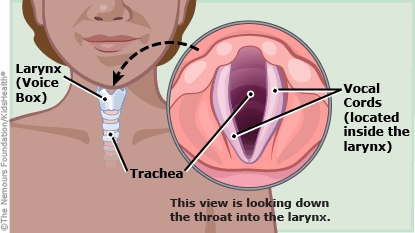Laryngitis: How to Care for Your Child
Laryngitis is common in children and usually gets better in a few weeks. Resting the voice can help speed up healing.


Vocal cords are muscles inside the voice box (also called the larynx) that move to make sounds when air passes through them. In laryngitis, the vocal cords become swollen and irritated. Laryngitis may cause your child to have a hoarse or raspy voice, have no voice at all, cough, clear the throat a lot, or have a sore or ticklish throat.
Laryngitis is usually caused by the common cold or other viruses. The virus may also cause symptoms such as low fever, runny or stuffy nose, and cough. A health care provider can usually diagnose laryngitis by asking about symptoms and doing a physical exam.
Laryngitis caused by a virus usually gets better on its own. Resting the voice is important to help the vocal cords heal.

-
Your child should speak as little as possible until the throat heals. Don't have your child whisper — it irritates the vocal cords. Encourage your child to write, draw, or act things out.
-
If the health care provider prescribed medicine, give it to your child as directed.
-
Have your child drink plenty of caffeine-free fluids.
-
Using a cool-mist humidifier might make your child feel better, especially during sleep.
-
If your child is uncomfortable, a medication may help:


Your child:
-
Has symptoms that last more than 2 weeks.
-
Has a fever above 101ºF (38.3ºC).
-
Seems to be getting worse.
-
Develops a loud, barking cough.
-
Makes a high-pitched or squeaking noise when breathing.

Your child: